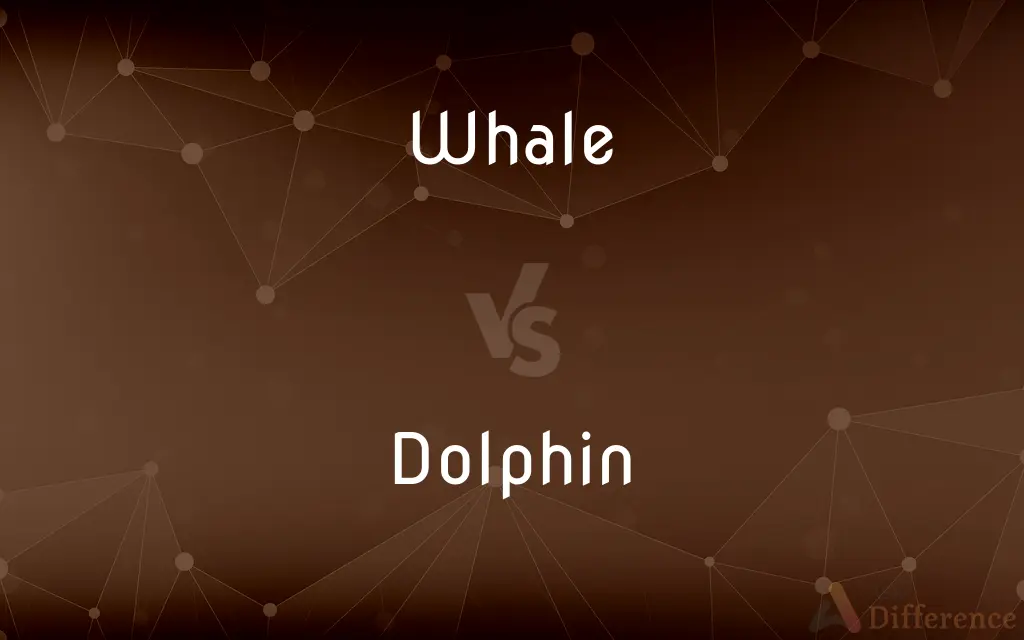Whale vs. Dolphin — What's the Difference?
Edited by Tayyaba Rehman — By Fiza Rafique — Updated on April 17, 2024
Whales are large marine mammals known for their size and filter-feeding mechanisms (in some species), whereas dolphins are smaller, highly intelligent, and known for their social behavior.

Difference Between Whale and Dolphin
Table of Contents
ADVERTISEMENT
Key Differences
Whales encompass a diverse group of marine mammals, including the enormous baleen whales like blue whales and humpbacks, which are known for filter feeding. Dolphins, on the other hand, are smaller, toothed marine mammals known for their agility and acrobatics.
Whales can range in size from the massive blue whale, which can exceed 100 feet in length, making it the largest animal on the planet, to much smaller species like the dwarf minke whale. Dolphins typically range from 6 to 12 feet in length, making them significantly smaller than most whales.
While many whale species are solitary or migrate in small family groups, dolphins are notably social creatures. They live in large, complex social groups called pods and engage in cooperative hunting and social bonding behaviors. This contrast highlights their social differences.
Whales, particularly baleen whales, communicate through low-frequency sounds and are capable of singing complex songs, particularly in the case of humpbacks. Dolphins are known for their high-frequency clicks and whistles, which they use for echolocation and communication.
In terms of reproduction, whales generally have longer gestation periods and fewer offspring, focusing on intensive parental care. Dolphins have shorter gestation periods but also invest heavily in the care of their young, often seen swimming alongside their mothers.
ADVERTISEMENT
Comparison Chart
Size
Ranges from large to extremely large
Generally smaller, between 6-12 feet
Feeding Mechanism
Filter feeders and predators
Predominantly predators
Social Structure
Often solitary or small groups
Highly social, live in large pods
Communication
Low-frequency sounds and songs
High-frequency clicks and whistles
Reproduction
Longer gestation, fewer offspring
Shorter gestation, invest in young
Compare with Definitions
Whale
Many species filter feed using baleen plates.
Baleen whales filter small animals from the ocean for food.
Dolphin
Often interact with humans and can be trained.
Dolphins in aquatic parks are trained to perform tricks.
Whale
Large marine mammals with diverse species including both baleen and toothed types.
The blue whale is the largest known animal to have ever existed.
Dolphin
Engage in complex social behaviors and live in pods.
Dolphins use coordinated strategies to hunt and communicate.
Whale
Typically have a single offspring at a time, known as a calf.
Whale calves stay with their mothers for extended periods.
Dolphin
Use echolocation to navigate and hunt underwater.
Dolphins emit clicks that bounce off objects, helping them locate prey.
Whale
Can communicate over great distances underwater.
Whales use song as a form of communication during the mating season.
Dolphin
Smaller, highly intelligent marine mammals.
Bottlenose dolphins are known for their problem-solving abilities.
Whale
Known for their migratory patterns covering long distances.
Gray whales travel up to 10,000 miles round-trip each year.
Dolphin
Known for their playful behavior and acrobatics above water.
Dolphins frequently leap from the water, which may aid in parasite removal.
Whale
Whales are a widely distributed and diverse group of fully aquatic placental marine mammals. They are an informal grouping within the infraorder Cetacea, which usually excludes dolphins and porpoises.
Dolphin
Dolphin is the common name of aquatic mammals within the infraorder Cetacea. The term dolphin usually refers to the extant families Delphinidae (the oceanic dolphins), Platanistidae (the Indian river dolphins), named Iniidae (the New World river dolphins), and Pontoporiidae (the brackish dolphins), and the extinct Lipotidae (baiji or Chinese river dolphin).
Whale
Any of various marine mammals of the order Cetacea; a cetacean.
Dolphin
Any of various marine toothed whales of the family Delphinidae, having a beaklike snout, a curved dorsal fin, and a slender streamlined body.
Whale
Any of various larger members of this order, including the blue whale, humpback whale, and right whale, in contrast to the porpoises and dolphins.
Dolphin
Any of several toothed whales inhabiting rivers and estuaries in South America and South Asia, having a long narrow beak, broad flippers, a flexible neck, and usually a reduced dorsal fin. A species native to the Yangtze River is thought to be extinct. Also called river dolphin.
Whale
(Informal) An impressive example
A whale of a story.
Dolphin
See dolphinfish.
Whale
To engage in the hunting of whales.
Dolphin
See pompano dolphinfish.
Whale
To strike or hit repeatedly and forcefully; thrash.
Dolphin
A buoy, pile, or group of piles used for mooring boats.
Whale
To strike or hit (a ball) with great force.
Dolphin
A group of piles used as a fender, as at a dock or around a bridge pier.
Whale
To strike or hit a person or thing repeatedly and forcefully
Whaled away at the plaster wall with a mallet.
Dolphin
A carnivorous aquatic mammal in one of several families of order Cetacea, famed for its intelligence and occasional willingness to approach humans.
Whale
To swing at a ball with great effort, especially repeatedly.
Dolphin
Tursiops truncatus, (Atlantic bottlenose dolphin) the most well-known species.
Whale
To attack vehemently
The poet whaled away at the critics.
Dolphin
A fish, the mahi-mahi or dorado, Coryphaena hippurus, with a dorsal fin that runs the length of the body, also known for iridescent coloration.
Whale
Any one of numerous large marine mammals comprising an informal group within infraorder Cetacea that usually excludes dolphins and porpoises.
Dolphin
(heraldry) A depiction of a fish, with a broad indented fin, usually embowed.
Whale
(by extension) Any species of Cetacea.
Dolphin
The dauphin, eldest son of the kings of France.
Whale
(figuratively) Something, or someone, that is very large.
Dolphin
(history) A mass of iron or lead hung from the yardarm, in readiness to be dropped through the deck and the hull of an enemy's vessel to sink it.
Whale
Something, or someone, that is excellent.
Dolphin
(nautical) A kind of wreath or strap of plaited cordage.
Whale
(gambling) In a casino, a person who routinely bets at the maximum limit allowable.
Dolphin
(nautical) A spar or buoy held by an anchor and furnished with a ring to which ships may fasten their cables.
Whale
An investor who deals with very large amounts of money.
Dolphin
(nautical) A mooring post on a wharf or beach.
Whale
A person who spends large amounts of money on things that are marketed to them.
Dolphin
(nautical) A permanent fender designed to protect a heavy boat or coastal structure from the impact of large floating objects such as ice or floating logs.
Whale
(intransitive) To hunt for whales.
Dolphin
One of the handles above the trunnions by which a gun was lifted.
Whale
To thrash, to flog, to beat vigorously or soundly.
Dolphin
(nautical) A man-made semi submerged maritime structure, usually installed to provide a fixed structure for temporary mooring, to prevent ships from drifting to shallow water or to serve as base for navigational aids.
Whale
Any aquatic mammal of the order Cetacea, especially any one of the large species, some of which become nearly one hundred feet long. Whales are hunted chiefly for their oil and baleen, or whalebone.
Dolphin
A cetacean of the genus Delphinus and allied genera (esp. Delphinus delphis); the true dolphin.
Whale
A very large person; impressive in size or qualities
Dolphin
The Coryphæna hippuris, a fish of about five feet in length, celebrated for its surprising changes of color when dying. It is the fish commonly known as the dolphin. The term is also applied to the related Coryphaena equisetis. Called also dolphinfish and (especially in Hawaii) mahimahi. See also dolphinfish and Coryphænoid.
Whale
Any of the larger cetacean mammals having a streamlined body and breathing through a blowhole on the head
Dolphin
A mass of iron or lead hung from the yardarm, in readiness to be dropped on the deck of an enemy's vessel.
Whale
Hunt for whales
Dolphin
A kind of wreath or strap of plaited cordage.
Dolphin
In old ordnance, one of the handles above the trunnions by which a cannon was lifted.
Dolphin
Large slender food and game fish widely distributed in warm seas (especially around Hawaii)
Dolphin
Any of various small toothed whales with a beaklike snout; larger than porpoises
Common Curiosities
What are the social structures of whales and dolphins?
Most whales are solitary or form small groups, whereas dolphins live in large, complex social groups known as pods.
How do whales and dolphins differ in their feeding habits?
Some whales use baleen to filter feed, while dolphins are active predators using echolocation to find their prey.
How do whales and dolphins communicate?
Whales use low-frequency sounds and songs, while dolphins use high-frequency clicks and whistles for communication and echolocation.
Are dolphins considered whales?
Yes, taxonomically, dolphins are a type of toothed whale within the cetacean family.
What distinguishes a whale from a dolphin?
Whales vary widely in size and include both baleen and toothed species, while dolphins are uniformly smaller and toothed.
Can dolphins be seen in freshwater?
Certain dolphin species, like the Amazon river dolphin, inhabit freshwater environments.
Do whales or dolphins have better social skills?
Dolphins are known for their exceptional social skills and complex group dynamics.
Which are bigger, whales or dolphins?
Whales are generally much larger than dolphins, with some species being the largest animals on Earth.
How do whales sleep?
Whales sleep by shutting down one half of their brain at a time, allowing them to continue breathing while resting.
What is the largest type of whale?
The blue whale is the largest type of whale and the largest animal known to have ever existed.
What threats do dolphins face?
Dolphins face threats from fishing gear, pollution, and habitat loss among other challenges.
Why are whales important to the ecosystem?
Whales play a critical role in the marine ecosystem, including nutrient recycling through their feeding and migration habits.
Are whales endangered?
Many whale species are considered endangered due to past hunting, habitat loss, and current threats like ship strikes and fishing gear entanglement.
Can dolphins and whales breed together?
While there are rare instances of hybrids between different dolphin species, true breeding between dolphins and other types of whales is not observed.
How long do whales and dolphins live?
Lifespans vary widely; some whales live up to 70 years or more, while many dolphins live 20-50 years.
Share Your Discovery

Previous Comparison
Legal vs. Ethical
Next Comparison
Trequel vs. PrequelAuthor Spotlight
Written by
Fiza RafiqueFiza Rafique is a skilled content writer at AskDifference.com, where she meticulously refines and enhances written pieces. Drawing from her vast editorial expertise, Fiza ensures clarity, accuracy, and precision in every article. Passionate about language, she continually seeks to elevate the quality of content for readers worldwide.
Edited by
Tayyaba RehmanTayyaba Rehman is a distinguished writer, currently serving as a primary contributor to askdifference.com. As a researcher in semantics and etymology, Tayyaba's passion for the complexity of languages and their distinctions has found a perfect home on the platform. Tayyaba delves into the intricacies of language, distinguishing between commonly confused words and phrases, thereby providing clarity for readers worldwide.














































